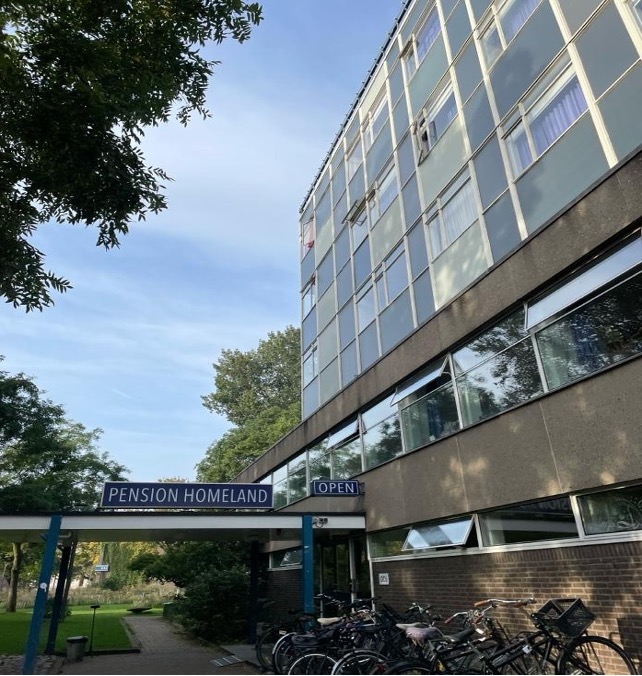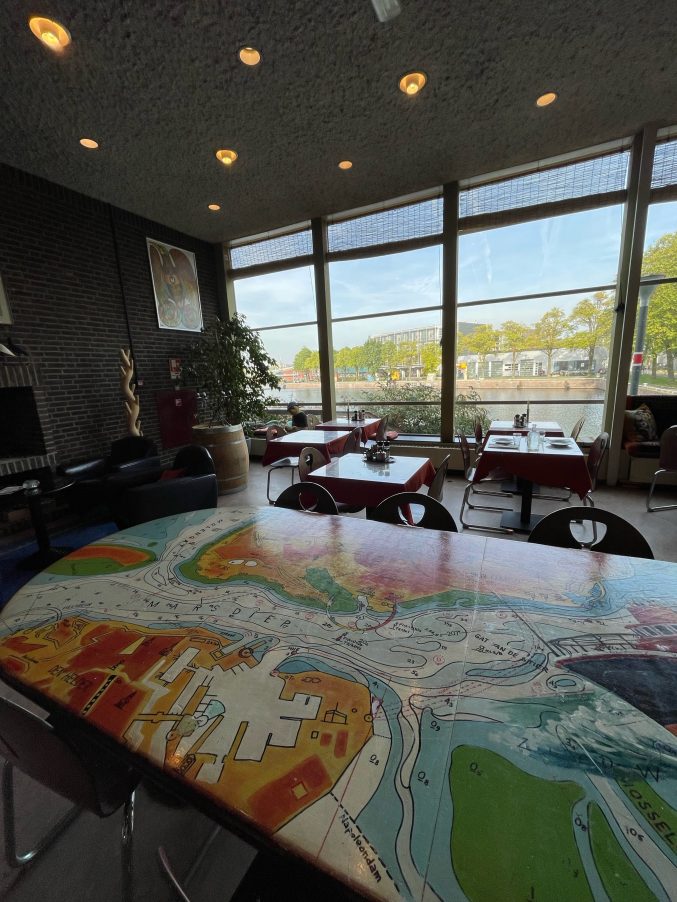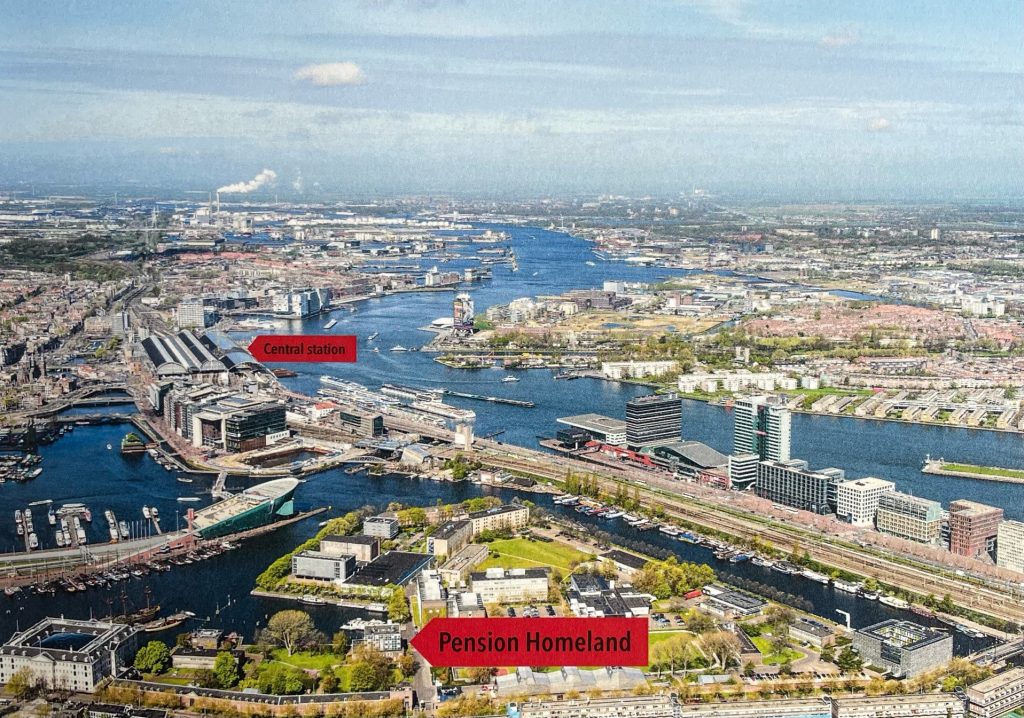Figure 1. The exterior of Pension Homeland (Ceescamel, 2022).
By Robyn Schnell
Nestled in the heart of the “Marineterrein” (navy terrain), Amsterdam, lies Pension Homeland, a former naval officers’ mess turned hotel, restaurant and brewery (Berg & Berkers, 2017). Pension Homeland is an example of a temporary placemaking approach, which depicts the value of such a flexible approach in an important heritage landscape, like Marineterrein. This blog post aims to outline the limitations and benefits of a temporary place-making approach by analysing Pension Homeland as a case study.
History of Marineterrein
Marineterrein’s rich history is entangled with that of the Dutch Navy, as the area was exclusively occupied by the Ministry of Defence for almost 400 years (Berg & Berkers, 2017). In 2013, the Ministry of Defence declared that the Navy would begin to vacate the majority of the area and that public access to Marineterrein would gradually be implemented (Berg & Berkers, 2018). After the Navy vacated the premises a decade ago, the building remained empty for three years before eventually becoming Pension Homeland seven years ago.
About this Blog series & the Heriland Blended Intensive Programme
The Blogs in this series (March-July 2024) were written by graduate students and early career professionals who participated in the Heriland Blended Intensive Programme “Heritage and the Planning of Landscapes” in October 2023 in Amsterdam, The Netherlands.
Are you interested in participating in the next iteration of the Heriland Blended Intensive Programme, “Heritage and Landscape Futures”, in Gothenburg, Sweden, in October 2024?
During fieldwork conducted in the Marineterrein, I had the opportunity to gain some insight into the history and design of Pension Homeland from the hotel’s manager and director, Agniet Helmens. According to Helmens, the name “Pension Homeland” originates from the former occupation of the area by the Dutch Navy. The Dutch term, “pension”, translates to “boarding house” and implies a sense of something being “homely”. Whereas the term “Homeland”, refers to the American television series, Homeland, which depicts the career of a CIA analyst. Pension Homeland’s name refers to both the former, secretive nature of the area under Dutch naval occupation, whilst also implying the current function of the building. In an interview published in the magazine, Marineterrein Amsterdam, Helmens explains the specific objective of Pension Homeland, as seen in its name. Helmens stated, “We want to create a place where people feel at home” (Berg & Berkers, 2017).

Due to the naval history of the landscape, the interior design of Pension Homeland follows a nautical theme, as evident in the aesthetic quality and design of the hotel. Like the name of Pension Homeland, the hotel’s interior design pays homage to the nautical heritage of the location.

Temporary Placemaking
With the changing and dynamic nature of Marineterrein, the flexibility of the temporary strategy implemented in Pension Homeland offers many benefits and opportunities to the broader landscape, such as providing opportunities for different uses of the building in the future. When Pension Homeland closes in three years, an opportunity will be provided for another use of the building it currently occupies. Helmens explained how the value of Pension Homeland can be derived from the process of temporary placemaking. Furthermore, the current occupation of the building will add another unique layer to the historic landscape whilst also increasing the site’s value.
Advantages
This approach has many benefits, such as its ability to elicit specific characteristics in vacant urban spaces and its ability to enhance a specific aesthetic or the functionality of a specific space for a limited period (Wesener, 2015). A fundamental aspect of the temporary placemaking process includes “small-scale interventions where participatory processes” are at the centre (Karachalis, 2021). Although Pension Homeland is a hotel that typically caters towards guests needing accommodation, the hotel invites members of the community to engage with the area. Whether it be sunbathing in the surrounding gardens of the “Voorwerf” (the former shipyard building) or taking a swim in the harbour in front of the hotel, Pension Homeland is an entity which thrives on community participation and engagement.
Limitations
Temporary placemaking is not without limitations. Academics such as Lauren Andres, point out that impermanent placemaking approaches are often criticised for their contribution towards the economic gentrification of a heritage landscape (Andres, 2013). In the case of Pension Homeland, a probable limitation of the temporary placemaking process could be the risk of the building being left vacant for some time after the hotel closes. Another limitation could be that the “transformative potential” of the impermanent strategy is limited and restricted and that the effects of this strategy can be temporary (Stevenson, 2019).

Since the Ministry of Defence still owns Marineterrein (Berg & Berkers, 2017), it can be argued that policies regarding the landscape may be implemented through a top-down approach that usually relies on “permanence, stability, linearity and control” (Andres, 2013). However, temporary placemaking strategies, as evident in the case of Pension Homeland, typically involve a bottom-up approach, which allows for positive community promotion and experimentation (Karachalis, 2021). An example of a bottom-up temporary approach would be the “Traces of Commerce” project of the broader Athens URBACT Refill project (Karachalis, 2021). Traces of Commerce is a “business incubator” that aims to revive an empty shopping arcade in Athens by allowing young entrepreneurs to occupy the empty spaces in the arcade to “test their commercial potential” without paying rent (URBACT Refill, 2018). In return, the entrepreneurs were expected to organise events for the public, such as meetings and workshops (Karachalis, n.d.). In the case of Athens, due to the increase of bottom-up movements and community participation, temporary placemaking approaches are continuously becoming involved in the political agenda of the city’s municipality (Karachalis, 2021). Therefore, a key aspect in the case study of Athens is the role of citizen participation and grassroots movements which are assimilated into municipal policies to utilise temporary placemaking to achieve solutions for the city’s urban problems (Karachalis, 2021). The Athens URBACT Refill project is a key example of how temporary placemaking, as well as community participation, can be successfully implemented in vacant spaces.
Historic Urban Landscape Approach
The Bureau Marineterrein Amsterdam, the organisation that oversees the daily management of Marineterrein (Berg & Berkers, 2017), could implement a strategy informed by the UNESCO Recommendation on the Historic Urban Landscape (HUL). HUL is an approach which looks beyond the physical preservation of an environment and primarily examines the human aspect of the environment, including its tangible and intangible characteristics (UNESCO, 2013). As a whole, HUL is the outcome of cultural and natural values being layered and intertwined over time (UNESCO, 2013). Such an approach would assist in developing and implementing a strategic plan of action by utilising HUL steps to critically examine the challenges that the urban landscape of Marineterrein currently faces. A HUL approach would also benefit the building currently occupied by Pension Homeland, by developing ideas for future use of the building after the hotel permanently closes in three years. An example of a future use of the building after Pension Homeland closes could be a bottom-up initiative similar to the Traces of Commerce Project in the Athens URBACT Refill project.
Despite the possible limitations of a temporary placemaking approach, Pension Homeland is a dynamic example of the advantages of such an impermanent strategy in terms of community participation and bottom-up approaches in policy making. Pension Homeland’s impermanent approach to placemaking depicts the exciting possibilities and opportunities that the future holds for both the community and the richly historical landscape of Marineterrein.
Bibliography
Andres, L. 2013. ‘Differential Spaces, Power Hierarchy and Collaborative Planning: A Critique of the Role of Temporary Uses in Shaping and Making Places’, Urban Studies 50(4), pp. 759-775.
Berg, J.J. & Berkers, M. 2017. (eds), Marineterrein Amsterdam Magazine, Bureau Marineterrein Amsterdam, Amsterdam.
Berg, J.J. & Berkers, M. 2018. (eds), Marineterrein Amsterdam Magazine, Bureau Marineterrein Amsterdam, Amsterdam.
Karachalis, N. 2021. ‘Temporary Use as a Participatory Placemaking Tool to Support Cultural Initiatives and Its Connection to City Marketing Strategies – The Case of Athens’, Sustainability 13(1652), pp. 1-13, DOI: https://doi.org/10.3390/su13041652.
Karachalis, N. 2023. ‘Traces of Commerce, Athens, Greece’, URBACT (Re)Making the City, <http://remakingthecity.urbact.eu/traces-of-commerce-athens-greece–66.case#:~:text=PROJECT%20DESCRIPTION&text=As%20an%20experiment%20to%20revitalise,such%20as%20workshops%20and%20seminars>, Published: n.d., Accessed: 18 November.
Stevenson, N. 2019. ‘The street party: pleasurable community practices and placemaking’, International Journal of Event and Festival Management 10(3), pp. 304-318.
URBACT Refill. 2023. A Journey Through Temporary Use, <https://issuu.com/refillthecity/docs/170842_refill_magazine_online_def_h>, Published: 28 March 2018, Accessed: 18 November.
United Nations Educational, Scientific and Cultural Organization (UNESCO), New Life for Historic Cities: The historic urban landscape approach explained, <https://whc.unesco.org/en/news/1026>, Published: 14 June 2013, Accessed: 10 January 2024.
Wesener, A. 2015. ‘Temporary urbanism and urban sustainability after a natural disaster: transitional community-initiated open spaces in Christchurch, New Zealand’. Journal of Urbanism: International Research on Placemaking and Urban Sustainability 8(4), pp. 406-422. DOI: https://doi.org/10.1080/17549175.2015.1061040
About the author
Robyn Schnell is a PhD student from the Department of Historical and Heritage Studies at the University of Pretoria in Pretoria, South Africa. The inspiration behind this blog post originated from the fieldwork she conducted in Marineterrein, Amsterdam in October 2023 as part of the Heriland Blended Intensive Programme.
Contact Robyn Schnell: robynschnell@gmail.com
About the Amsterdam Marineterrein MiniSeries
During the Heriland Blended program Multispaces Living Lab, students worked on the Amsterdam Marineterrein to prepare proposals. This is the last of three posts presenting a heritage-informed perspective on the Marineterrein, part of the historic docks of Amsterdam.

